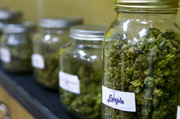
After alcohol and marijuana, what mood altering substance is the next most popular among U.S. high school students? You might reasonably suspect prescription pain relievers or prescription stimulants. But in a 2012 survey of drug use in the past year by 9th to 12th graders, synthetic marijuana took third place.
“Synthetic marijuana” refers to a group of products that consist of dried herbs or other plant material that has been sprayed or soaked with chemicals. The structures of the chemicals mimic those of the psychoactive substances in marijuana (cannabinoids). They come from a laboratory rather than a natural source, so they are classified as designer drugs. Synthetic cannabinoids are frequently more powerful than natural ones, with a wider range of physical and mental effects—some of which can be deadly.
Spice and K2 are the best-known brands. Other street and shelf names for these products include Black Mamba, Bliss, Fire n’ Ice, G-Force, Genie, Solar Fire, Spice Gold, and Yucatan Fire. Packets or pouches of synthetic marijuana, sold as incense or potpourri online and in head shops and convenience stores, are labeled “Not for Human Consumption.”
Smoking synthetic marijuana appeals to teens and young adults who expect their urine will be tested for drugs but who still want to get high. They know synthetic cannabinoids, unlike THC from conventional marijuana, is not detectable without special procedures. To close this loophole, specific tests for synthetic marijuana (and bath salts) are becoming more common in urine drug panels used to screen the military, individuals monitored by probation and parole authorities, and individuals engaged in addiction treatment.
Synthetic marijuana preparations became available in this country in the mid-2000s. Some consumers, seeking to duplicate the experience of smoking marijuana, get more than they bargained for. The physical effects of these drugs can be sudden, unpleasant, and dangerous. Examples include increases in heart rate and blood pressure, seizures, abnormal heart rhythm, tremor, vomiting, and kidney damage. Synthetic marijuana has precipitated strokes and heart attacks resulting in disability and death.
The effects of synthetic marijuana on the mind can also be scary. Psychosis, with hallucinations and/or paranoia, can persist for weeks and in some cases may be permanent. Reported mental effects also include agitation (sometimes with violence to self or others), disorientation, and the onset of chronic depression. Extreme anxiety is common. A 20-year-old man said K2 was “like smoking a panic attack.”
Because of these dangers, local and federal authorities have been trying to eliminate synthetic marijuana from the marketplace. But, as with bath salts, it is difficult to reduce the supply because unscrupulous producers modify the chemical ingredients and packaging on a regular basis, and return their products to the shelves. With no standardization, regulation, or official testing of these products, it is impossible for consumers to know what they are smoking, or what the physical or mental effects will be.
The status of salvia, or Salvia divinorum, parallels that of synthetic marijuana because it can be legally purchased in some jurisdictions (no federal regulations are yet in place, and only about half the states have banned or regulated it) and may have unexpectedly powerful mental effects.
Salvia divinorum is a soft-leaved, hallucinogenic plant in the mint family that is native to southern Mexico. It has been used there for centuries as a medicinal herb (to treat diarrhea, for example) and for shamanic visions. It contains Salvinorin A, which stimulates kappa-opioid receptors and is the most potent naturally occurring hallucinogen. While stimulation of mu-opioid receptors is generally euphoric, stimulation of kappa-opioid receptors is generally dysphoric and may alter perception. Salvia leaves may be chewed, and dried leaves may be smoked. Salvinorin A extract may be prepared as a tea or vaporized and inhaled. Physical effects may include dizziness, nausea, and loss of coordination. Mental effects vary with the amount of drug absorbed and may include intense hallucinations, a sense of traveling through space and time, and total dissociation from reality. Pro-drug websites recommend having a sitter look after you if you take salvia and mention that individuals who have taken a concentrated dose rarely choose to do it again.
As with a host of legal and illegal substances, reducing the demand for these drugs may prove difficult. Addiction psychiatrist Edward Khantzian describes individuals with addiction as deficient in self-care, and when people consume synthetic marijuana or salvia they demonstrate indifference to their personal safety. I once attempted to draw patients in addiction treatment into a discussion of risk and preventive health practices with an opening question I thought would make everyone cringe: “Has anyone here ever played Russian roulette?” Two hands went up.
